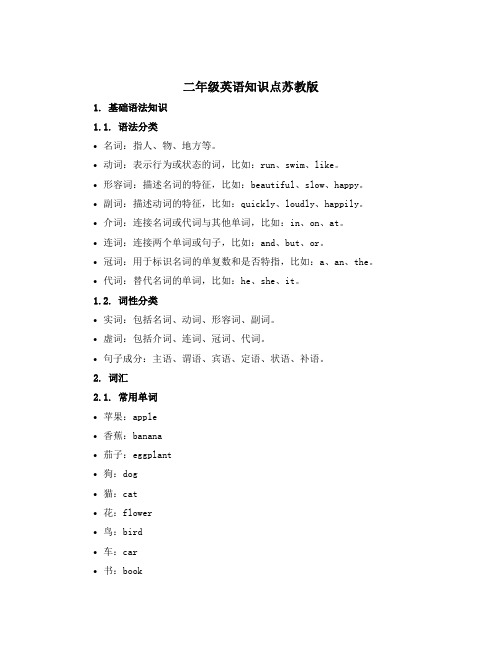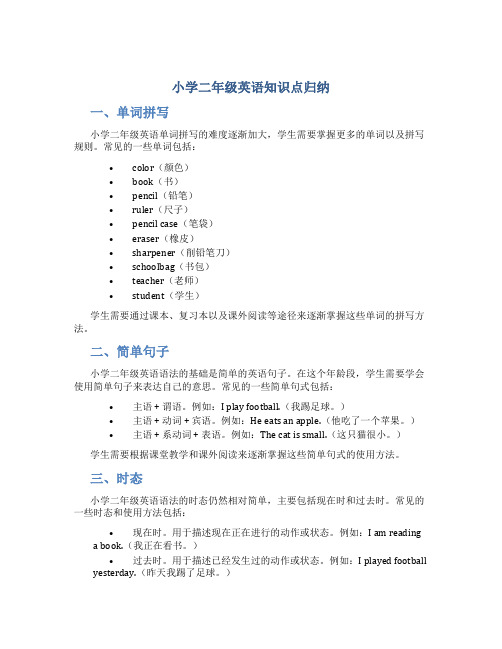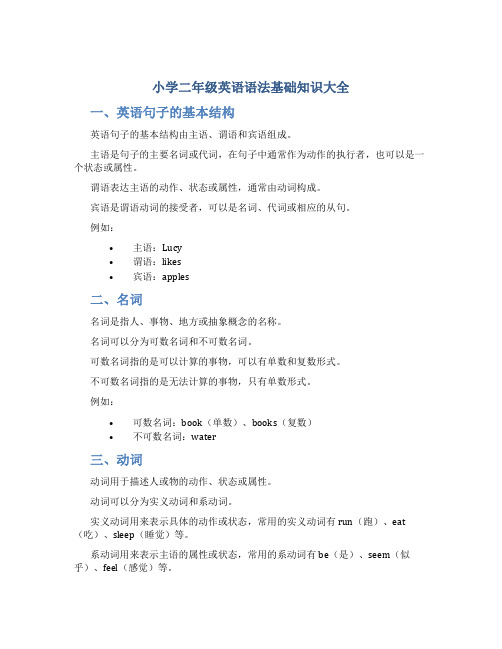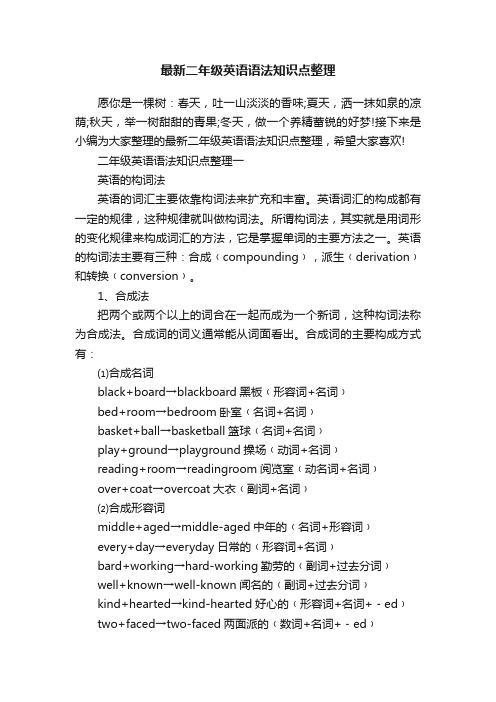小学二年级学生英语语法学习知识点
二年级英语知识点苏教版

二年级英语知识点苏教版1. 基础语法知识1.1. 语法分类•名词:指人、物、地方等。
•动词:表示行为或状态的词,比如:run、swim、like。
•形容词:描述名词的特征,比如:beautiful、slow、happy。
•副词:描述动词的特征,比如:quickly、loudly、happily。
•介词:连接名词或代词与其他单词,比如:in、on、at。
•连词:连接两个单词或句子,比如:and、but、or。
•冠词:用于标识名词的单复数和是否特指,比如:a、an、the。
•代词:替代名词的单词,比如:he、she、it。
1.2. 词性分类•实词:包括名词、动词、形容词、副词。
•虚词:包括介词、连词、冠词、代词。
•句子成分:主语、谓语、宾语、定语、状语、补语。
2. 词汇2.1. 常用单词•苹果:apple•香蕉:banana•茄子:eggplant•狗:dog•猫:cat•花:flower•鸟:bird•车:car•书:book•英语:English2.2. 常用短语•你好:Hello•再见:Goodbye•谢谢:Thank you•对不起:I’m sorry•非常好:Very good•很高兴见到你:Nice to meet you•请进:Please come in•早上好:Good morning•晚上好:Good evening3. 句型3.1. 简单句•苹果很好吃。
The apple is very tasty.•猫喜欢睡觉。
The cat likes to sleep.•我爱英语。
I love English.•我的书在桌子上。
My book is on the table.3.2. 复合句•我的狗会叫,也会跑。
My dog can bark and run.•看到花,我感到很开心。
I am happy to see the flowers.•我喜欢吃水果,比如苹果和香蕉。
I like to eat fruits, such as apple and banana.4. 阅读和写作4.1. 阅读理解•读一些简单的故事和短文,理解其中的内容。
北京小学二年级英语知识点

北京小学二年级英语知识点一、单词拼读与语音1.1 英语音标在学习英语时,了解英语音标非常重要,需要掌握国际音标,并熟练掌握所有的音标发音。
1.2 字母发音掌握字母的发音也很重要。
在二年级,学生需要掌握26个英文字母的发音和大小写形式。
1.3 单词拼写学生需要学习基础的单词拼写规则,如音节重音和读音规则等。
二、基础语法2.1 词汇量在二年级英语学习中,学生要掌握基本的词汇量。
学生需要通过课堂、家庭和其他渠道来积累词汇,为以后深入学习做铺垫。
2.2 名词学生需要掌握一些最基本的名词,如人名、动物、食物以及物品等。
2.3 动词动词是语言的动力所在,学生需要掌握一些最基本的动词,如看、听、跳、奔跑、游泳、跳舞以及说等。
2.4 形容词形容词是为了形容名词而存在的,学生需要掌握一些基本的形容词,如好、坏、高、矮、快、慢等。
2.5 代词学生需要掌握一些基本的代词,如我、你、他、她、它以及我们、你们和他们等。
2.6 冠词冠词是指在名词前用来限定名词特指或泛指的词语。
学生需要掌握一些基本的冠词,如a、an、the等。
2.7 数量词数量词是用来表示事物数量或次数的词语。
学生需要掌握一些基本的数量词,如one、two、three等。
三、应用能力3.1 对话基础学生需要学习英语对话的基础,包括问候、自我介绍、问询以及表达想法等。
此外,学生还需要学会一些简单的交际用语,例如“请再说一遍”、“请在慢点说一遍”等。
3.2 短文阅读学生需要学习阅读简单的英语短文,理解短文的基本内容并回答问题。
3.3 写作能力学生需要学会进行简单句和段落的写作,例如自我介绍、描述周围环境以及介绍自己的家人、朋友等。
四、学习策略4.1 词语记忆学习英语,词汇量是非常重要的,学生需要掌握记忆单词的方法,包括组词、分类记忆等。
4.2 听力训练英语听力是英语学习的关键,学生需要进行听力功课,才能提高对语言的理解能力和应用能力。
4.3 参与活动学生需要参与英语活动,包括唱歌、朗读、演讲等,以此来提高英语应用能力。
二年级英语知识点整理归纳

二年级英语知识点整理归纳打盹会做梦,学习会圆梦。
学习外语并不难,学习外语就像交挚友一样,挚友是越交越熟的,每天见面,挚友之间就亲近无间了。
重复重复再重复,娴熟娴熟再娴熟,是学会英语的不二法门。
下面是我给大家整理的一些二年级英语的学问点,盼望对大家有所协助。
英语二年级语法学问点形容词比拟级和级形容词是修饰名词、表示名词属性的词。
学习形容词,很重要的一局部内容就是形容词的比拟级、级。
关于它们的构成,之前已经有所归纳,请看形容词比拟级的构成方法。
形容词比拟级的用法一、在than句中:He is taller than I.(口语中常作:He is taller than me.)他比我高。
He is two heads taller than I.他比我高出两个头。
二、在which,or?句中,表示两者比拟:Which is bigger,the sun or the moon?太阳和月亮,哪一个更大?三、比拟级+and+比拟级:Its getting darker and darker.天越来越黑了。
He is getting more and more interested in sports.他对体育越来越感爱好。
四、The more,the more:The more you eat,the more you want.你越吃越想要。
五、形容词比拟级前可受much,far,a lot,still,no,a little,even,any 修饰,表示超出的程度:We have a much better life now.我们此时此刻的日子好得多了。
The buildings look far uglier in London than here.伦敦的建筑比这儿的难看得多。
This story is even more interesting than that one.这个故事比那个更好玩。
知识点二年级动词时态知识点总结

知识点二年级动词时态知识点总结动词时态是指动词在不同时间下所表示的状态或动作的形式。
在二年级学习英语时,学习动词时态是一个重要的语法知识点。
本文将对二年级学生需要掌握的动词时态知识进行总结,帮助他们更好地理解和运用。
一、一般现在时(Simple Present)一般现在时表示经常性的动作、习惯、真理或客观事实。
1. 形式:主语 + 动词原形(第三人称单数加-s)2. 例句:- I play with my friends every day.(我每天和朋友们一起玩。
)- He likes to eat apples.(他喜欢吃苹果。
)- Water boils at 100 degrees Celsius.(水在100摄氏度沸腾。
)二、一般过去时(Simple Past)一般过去时表示过去发生的动作或状态。
1. 形式:主语 + 动词过去式2. 例句:- We visited the zoo last week.(我们上星期参观了动物园。
)- She watched a movie yesterday.(她昨天看了一部电影。
)- They played soccer in the park.(他们在公园里踢足球。
)三、将来时态(Future Tense)将来时态表示将来要发生的动作或状态。
1. 形式:- 主语 + will + 动词原形(表示预测、意愿或承诺的未来动作)- 主语 + be going to + 动词原形(表示计划、打算或预测的未来动作)2. 例句:- They will go to the beach this weekend.(他们将在这个周末去海滩。
)- I am going to study hard for the exam.(我打算好好备考。
)- He will be a doctor in the future.(他将来会成为一名医生。
)四、现在进行时(Present Continuous)现在进行时表示正在进行的动作,也可用来表示将来安排好的近期动作。
小学二年级英语知识点

1.基本的问候语和礼貌用语:- Hello! 你好!- Good morning/afternoon/evening! 早上/下午/晚上好!- How are you? 你好吗?- Nice to meet you! 很高兴认识你!- Thank you! 谢谢!2.数字和计数:-数字1-100的基本表达-数字的读法和写法-问询、回答年龄的句型3.基本的日常生活用语:- What's your name? 你叫什么名字?- How old are you? 你几岁了?- Where do you live? 你住在哪里?- What's your favorite color/animal/food? 你最喜欢的颜色/动物/食物是什么?4.常见的动词:- be 动词的基本用法:am, is, are- have 拥有;使用的基本用法5.基本的形容词:- 形容词的基本用法:big, small, tall, short, happy, sad, nice, mean等6.基本的名词:- 主要的物体名称:ball, car, cat, dog, apple, book, pencil 等- 人称代词:I, you, he, she, it, we, they7.基本的人称代词:- 主格:I, you, he, she, it, we, they- 宾格:me, you, him, her, it, us, them8.基本的地点介词:- in, on, under, behind, in front of, beside等的基本用法9.基本的动物和颜色:- 基本的动物名称:dog, cat, bird, fish, rabbit等- 基本的颜色名称:red, blue, yellow, green, black, white等10.日常生活中基本的句型和表达:- What do you like to do? 你喜欢做什么?- Where is the park/school/store? 公园/学校/商店在哪里?- Can I have...? 我可以要...吗?-I don't know. 我不知道。
二年级英语语法的知识点

二年级英语语法的知识点二年级英语语法的知识点人称主格宾格形容词名词性第一人称单数 I me my mine myself复数 we us our ours ourselves第二人称单数 you you your yours yourself复数 you you your yours yourselves第三人称单数 she her her hers herselfhe him his his himselfit it its its this that itself复数 they them their theirs these those themselves 小学二年级英语语法知识点一般现在时:通常用 "usually, often, every day, sometimes"。
肯定句:I go to school on foot every day.She goes to school on foot every day.一般疑问句:Do you jump high? Yes, I do. / No, I dont.Does he jump high? Yes, he does. / No, he doesnt.否定句:We dont go to school on Sundays.My mother doesnt like watching TV in the evening.二年级英语语法知识点归纳名词复数规则:1、一般情况下,直接加-s如:book-books, bag-bags, cat-cats, bed-beds2、以s. x. sh. ch结尾,加-es如:bus-buses, box-boxes, brush-brushes, watch-watches3、以“辅音字母+y”结尾,变y为i, 再加-es如:family-families, strawberry-strawberries4、以“f或fe”结尾,变f或fe为v, 再加-es如:knife-knives, wife-wives5、不规则名词复数:man-men, woman-women, policeman-policemen,policewoman-policewomen,mouse-mice, child-children, foot-feet, tooth-teeth, fish-fish, people-peopleChinese-Chinese, Japanese-Japanese 二年级英语语法的知识点。
小学二年级英语知识点归纳

小学二年级英语知识点归纳一、单词拼写小学二年级英语单词拼写的难度逐渐加大,学生需要掌握更多的单词以及拼写规则。
常见的一些单词包括:•color(颜色)•book(书)•pencil(铅笔)•ruler(尺子)•pencil case(笔袋)•eraser(橡皮)•sharpener(削铅笔刀)•schoolbag(书包)•teacher(老师)•student(学生)学生需要通过课本、复习本以及课外阅读等途径来逐渐掌握这些单词的拼写方法。
二、简单句子小学二年级英语语法的基础是简单的英语句子。
在这个年龄段,学生需要学会使用简单句子来表达自己的意思。
常见的一些简单句式包括:•主语 + 谓语。
例如:I play football.(我踢足球。
)•主语 + 动词 + 宾语。
例如:He eats an apple.(他吃了一个苹果。
)•主语 + 系动词 + 表语。
例如:The cat is small.(这只猫很小。
)学生需要根据课堂教学和课外阅读来逐渐掌握这些简单句式的使用方法。
三、时态小学二年级英语语法的时态仍然相对简单,主要包括现在时和过去时。
常见的一些时态和使用方法包括:•现在时。
用于描述现在正在进行的动作或状态。
例如:I am readinga book.(我正在看书。
)•过去时。
用于描述已经发生过的动作或状态。
例如:I played football yesterday.(昨天我踢了足球。
)学生需要通过课堂教学和课外阅读来逐渐掌握这两种时态的使用方法。
四、基本词汇量小学二年级英语学生需要逐渐扩展自己的词汇量。
常见的一些基本词汇量包括:•数字。
例如:one(1)、two(2)、three(3)等。
•颜色。
例如:red(红色)、yellow(黄色)、green(绿色)等。
•动物。
例如:dog(狗)、cat(猫)、bird(鸟)等。
•水果。
例如:apple(苹果)、banana(香蕉)、orange(橙子)等。
小学二年级英语语法汇总

小学二年级英语语法汇总如下:一、基本时态与动词形式1.一般现在时:o使用be动词(am/is/are)描述当前状态或习惯性动作。
o肯定和否定句结构:I am (not) a student. They are (not) playing.o一般疑问句结构及其回答:Are you a student? Yes, I am. / No, I'm not.1.动词的-ing形式:o表示正在进行的动作。
o构成方式:大多数动词加-ing(如walk-walking),以e结尾的动词去e加-ing (如come-coming),以一个元音和一个辅音结尾的重读闭音节动词,双写末尾辅音字母再加-ing(如run-running)。
o句子结构:be + verb-ing(如I am playing football.)。
二、句子结构1.陈述句(声明句):用于陈述事实或表达观点。
o肯定句:I like apples.o否定句:I don't like apples.1.疑问句:用于提出问题。
o一般疑问句:Are you happy?o特殊疑问句(如使用what, where, how等疑问词):What is your name?1.there be句型:用于描述某处存在某物。
o肯定句:There is a book on the table.o否定句:There isn't a book on the table.o疑问句:Is there a book on the table?三、名词与代词1.名词复数规则:o一般情况下,直接加-s(如book-books)。
o以s, x, sh, ch结尾的名词,加-es(如bus-buses)。
o以“辅音字母+y”结尾的名词,变y为i,再加-es(如family-families)。
o以“f或fe”结尾的名词,变f或fe为v,再加-es(如knife-knives)。
二年级英语知识点归纳大全

二年级英语知识点归纳大全一、单词拼写扩展单词量是学习英语的第一步,对于二年级的小朋友们来说,建议从基础单词开始学起,如人称代词I、you、he、she、it等。
二、基础语法二年级的英语语法由简至繁,主要内容包括句子结构、名词和动词的区别、形容词和副词的区别等。
三、常用词组常用词组是小学英语句子表达的基础,如介词短语in front of、behind、on等。
四、数词和数量表达二年级学生需了解基本的数词和数量表达,如数字1-20、颜色、大小等。
五、时间、日期和星期表达英语中的时间、日期和星期表达方式与中文不同,二年级的学生需学会表示时间、日期和星期的相关语句。
六、基础句型二年级学生需学会基础句型,如肯定句、否定句、一般疑问句等,例如,I ama student.(我是一个学生。
)七、常见动词二年级学生需学会常见的动词,如play、eat、drink、run、walk等,通过学习常见动词,学生能够更好地进行语言表达。
八、常见形容词和副词形容词和副词用于描述名词和动词,二年级的学生需学会常见的形容词和副词,如big、small、quickly、slowly等。
九、个人信息表达学生需要会用英语表达自己的个人信息,如姓名、年龄、家庭住址等。
十、经典童谣和儿歌学生可以通过学习经典的童谣和儿歌来培养英语语感和发音,如《Twinkle, Twinkle, Little Star》。
十一、日常用语学生需要学会日常生活中常用的英语语句,如问候语、道别语等。
例如,Good morning!(早上好!)十二、课堂表达学生需要掌握基本的课堂表达方式,如请假、提问等。
以上就是二年级英语知识点归纳大全,希望能帮助孩子们更好地掌握英语知识点,提高英语水平。
英语小学生二年级语法的汇总

英语小学生二年级语法的汇总小学生英语语法的重点【现在进行时】1.现在进行时表示现在正在进行或发生的动作,也可表示当前一段时间内的活动或现阶段正在进行的动作。
2.现在进行时的肯定句基本结构为be动词ing。
3.现在进行时的否定句在be后加not。
4.现在进行时的一般疑问句把be动词调到句首。
5.现在进行时的非凡疑问的基本结构为:疑问词不达意 be 主语动词ing但疑问词当主语时其结构为:疑问词不达意 be 动词ing动词加ing的变化规则1.一般情况下,直接加ing,如:cook-cooking2.以不发音的e结尾,去e加ing,如:make-making,taste-tasting3.假如末尾是一个元音字母和一个辅音字母,双写末尾的辅音字母,再加ing,如:run-running, stop-stopping 英语语法知识点【一般过去时态】(a) be 动词的过去式:I/He/she/it was(not). You/we/they were.一般疑问句was, were 放在句首。
(b) 动词过去式:肯定句: I watched cartoons.She visited the zoo.一般疑问句: Did you read book last night Yes, I did. No, I didnt.Did she clean the desk just now Yes, she did. No, she didnt.否定句: They didnt go the the part yesterday.He didnt make model ships last week.(3)动词过去式的变化:规则动词的变化:Most verbs +ed eg. planted,watered,climbed。
Verbs ending in e +d eg liked。
Verbs ending in a consonant +y --y +ied eg : study-studiedShort verbs ending in a vowel + a consonant eg: stop --stopped不规则动词的变化:is/am-was,are-were,do-did,have/has-had,make-made,fly-flew/u:/eat-ate,take-took,run-ran,sing-sang,drink-drank 等等英语二年级的语法【一般现在时】通常用 usually, often, every day, sometimes。
小学二年级英语语法基础知识大全

小学二年级英语语法基础知识大全一、英语句子的基本结构英语句子的基本结构由主语、谓语和宾语组成。
主语是句子的主要名词或代词,在句子中通常作为动作的执行者,也可以是一个状态或属性。
谓语表达主语的动作、状态或属性,通常由动词构成。
宾语是谓语动词的接受者,可以是名词、代词或相应的从句。
例如:•主语:Lucy•谓语:likes•宾语:apples二、名词名词是指人、事物、地方或抽象概念的名称。
名词可以分为可数名词和不可数名词。
可数名词指的是可以计算的事物,可以有单数和复数形式。
不可数名词指的是无法计算的事物,只有单数形式。
例如:•可数名词:book(单数)、books(复数)•不可数名词:water三、动词动词用于描述人或物的动作、状态或属性。
动词可以分为实义动词和系动词。
实义动词用来表示具体的动作或状态,常用的实义动词有run(跑)、eat (吃)、sleep(睡觉)等。
系动词用来表示主语的属性或状态,常用的系动词有be(是)、seem(似乎)、feel(感觉)等。
例如:•实义动词:Tom is running.•系动词:She is beautiful.四、形容词形容词用来描述名词的特征或性质。
形容词可以放在名词前面作为定语,也可以作为表语放在系动词后面。
形容词有比较级和最高级两种形式,用来比较事物的特征或性质的程度。
例如:•定语:a big house•表语:The house is big.五、副词副词用来修饰动词、形容词或其他副词。
副词可以表示时间、地点、方式、程度等。
例如:•修饰动词:She runs quickly.•修饰形容词:He is very tall.•修饰副词:He runs very quickly.六、代词代词用来代替名词,起到替代的作用。
人称代词用来代替人,包括主格和宾格两种形式。
反身代词用来表示动作反身,以自己为对象。
指示代词用来指示事物的位置或距离。
例如:•人称代词:I love you.•反身代词:He hurt himself.•指示代词:This is my book.七、介词介词用来表示人或物之间的关系。
二年级英语知识点整理归纳

二年级英语知识点整理归纳一、基础知识1. 字母表二年级学生需要熟记26个英文字母的大小写形式及其发音。
在此基础上,掌握字母表排列的顺序,并能熟练拼读和书写单词。
2. 词汇二年级学生需要掌握700个左右的基础词汇。
这些词汇主要涵盖日常生活中的物品、动物、颜色、数字、时间、家庭和衣物等常见内容。
掌握这些词汇能够便于学生进行日常英语的表达和理解。
二、语法知识1. 三单形式三单形式是表示第三人称单数的时态,主要用于谓语动词后。
在三单形式中,动词需要进行变化,例如:•he eat s an apple.(他吃一个苹果。
)•she like s to sing.(她喜欢唱歌。
)2. 一般现在时一般现在时是英语最基本的时态形式之一,主要表示现在发生或习惯性发生的事情。
在这种时态下,主语和谓语动词的形式一般不发生变化,例如:•I go to school every day.(我每天去学校。
)•They like playing football.(他们喜欢踢足球。
)3. 疑问句疑问句是用来询问别人意见、问题或信息的句子。
在构造疑问句的时候,需要使用疑问词,并将主语和谓语动词位置颠倒,例如:•What is your name?(你叫什么名字?)•Do you like ice cream?(你喜欢冰淇淋吗?)三、听说读写技能1. 听听是英语学习的基础技能之一。
二年级学生首先需要能够辨别英语语音,听懂简单的对话和指令,如:•Open your book.(打开你的书。
)•What’s your name?(你叫什么名字?)2. 说说是英语学习的重要技能之一。
二年级学生需要能够用英语句子表达自己的想法和意见,例如:•I have a toy car.(我有一辆玩具车。
)•My favorite color is blue.(我最喜欢的颜色是蓝色。
)3. 读阅读是英语学习的重要技能之一。
二年级学生需要能够读懂简单的英语短文和故事,理解作者想要表达的意思和信息。
二年级英语的语法知识点归纳.doc

二年级英语的语法知识点归纳二年级英语的语法知识点归纳1:宾语一、名词作宾语Show your passport, please.请出示护照。
二、代词作宾语He didn t say anything.他什么也没说。
三、数词作宾语How many do you want? - I want two.你要几个?- 我要两个。
四、名词化的形容词作宾语They sent the injured to hospital.他们把伤员送到医院。
五、不定式或ing形式作宾语They asked to see my passport.他们要求看我的护照。
I enjoy working with you.我和你们一道工作很愉快。
六、从句作宾语Did you write down what he said?你把他的话记下了没有?二年级英语的语法知识点归纳2:名词一、定义名词是表示人或事物名称的词。
它既可以表示具体的东西,也可以是表示抽象的东西。
二、分类1. 名词可以根据意义分为普通名词和专有名词如:John is a studentstudent是普通名词,John是专有名词普通名词前可以用不定冠词a/an, 定冠词the 或不加冠词,专有名词前一般不加冠词,专有名词的首字母要大写。
2. 普通名词又可以分为个体名词、集体名词、物质名词和抽象名词,其中个体名词与集体名词是可数名词,物质名词和抽象名称是不可数名词。
3. 专有名词专有名词是表示人名、地名、团体、机构、组织等的专有名词,多为独一无二的事物。
三、名词的数1、名词分为可数名词和不可数名词。
可数名词可以数的名词不可数名词数不清(没有复数)Drink?milk tea water orange juice coke coffee porridgeFood?rice bread meat fish fruit cake dumplings2、可数名词与不定冠词a(an)连用有数数形式,不可数名词不能与不定冠词a(an)连用,没有复数形式many+可数名词复数much/a little+不可数名词some, any , a lot of (lots of) 两者都可以修饰。
最新二年级英语语法知识点整理

最新二年级英语语法知识点整理愿你是一棵树:春天,吐一山淡淡的香味;夏天,洒一抹如泉的凉荫;秋天,举一树甜甜的青果;冬天,做一个养精蓄锐的好梦!接下来是小编为大家整理的最新二年级英语语法知识点整理,希望大家喜欢!二年级英语语法知识点整理一英语的构词法英语的词汇主要依靠构词法来扩充和丰富。
英语词汇的构成都有一定的规律,这种规律就叫做构词法。
所谓构词法,其实就是用词形的变化规律来构成词汇的方法,它是掌握单词的主要方法之一。
英语的构词法主要有三种:合成﹙compounding﹚,派生﹙derivation﹚和转换﹙conversion﹚。
1、合成法把两个或两个以上的词合在一起而成为一个新词,这种构词法称为合成法。
合成词的词义通常能从词面看出。
合成词的主要构成方式有:⑴合成名词black+board→blackboard黑板﹙形容词+名词﹚bed+r oom→bedroom卧室﹙名词+名词﹚basket+ball→basketball篮球﹙名词+名词﹚play+ground→playground操场﹙动词+名词﹚reading+room→readingroom阅览室﹙动名词+名词﹚over+coat→overcoat大衣﹙副词+名词﹚⑵合成形容词middle+aged→middle-aged中年的﹙名词+形容词﹚every+day→everyday日常的﹙形容词+名词﹚bard+working→hard-working勤劳的﹙副词+过去分词﹚well+known→well-known闻名的﹙副词+过去分词﹚kind+hearted→kind-hearted好心的﹙形容词+名词+﹣ed﹚two+faced→two-faced两面派的﹙数词+名词+﹣ed﹚⑶合成副词some+times→sometimes有时﹙形容词+名词﹚may+be→maybe大概﹙情态动词+动词﹚up+stairs→upstairs在楼上﹙副词+名词﹚for+ever→forever永远﹙介词+副词﹚⑷合成代词①不定代词+名词somebody﹙someone﹚omethingnobody﹙noone﹚everythinganybody﹙anyone﹚anythingnothingeveryoouy﹙everyone﹚②代词宾格或物主代词+self﹙selves﹚herselfourselves⑸合成动词white+wash→whitewash粉刷﹙形容词+动词﹚over+come→overcome克服﹙副词+动词﹚sleep+walk→sleepwalk梦游﹙名词+动词﹚2、派生法在一个单词﹙词根﹚的前或后加上一个词缀,构成一个新词,这种构词法称为派生法。
小学二年级英语知识点

小学二年级英语知识点小学二年级的英语知识点主要涉及基本的词汇、语法、听说读写等方面。
以下是关于这些方面的详细知识点:1.基本词汇:●学习基本的日常用词,包括问候、数字、颜色、家庭成员、动物、食物等。
●掌握一些常见的动词和形容词,如play(玩)、eat(吃)、big(大)、small(小)等。
2.语音与拼读:●学习英语字母表及其发音,了解元音和辅音的区别。
●练习简单的单词拼读和音节划分。
3.句型构造:●学习简单的英语句型,如主语+动词,主语+动词+宾语等。
●练习构造简单的肯定句和否定句,如I like apples.(我喜欢苹果。
)、I don't like apples.(我不喜欢苹果。
)。
4.日常用语:●学习日常交际用语,如问候语、感谢、道歉、请示等。
●能用简单的英语进行日常生活交流,如自我介绍、询问他人姓名、年龄等。
5.基本语法:●学习名词的单数和复数形式,如cat(猫)变成cats(猫们)。
●学习形容词的比较级和最高级,如big(大)变成bigger(更大)、biggest(最大)。
●了解动词的现在进行时,如I am eating.(我正在吃饭。
)6.听力与口语:●听懂简单的日常用语和指令,如问候、点名、数数等。
●能用简单的句子回答老师或同学的问题。
7.阅读:●阅读简单的短文和绘本,了解基本的故事情节和内容。
●能根据图片和简单的句子回答问题。
8.写作:●练习书写英文字母和简单的单词。
●通过图片或提示写出简单的句子,如介绍自己的家庭、朋友等。
9.唱歌和游戏:●通过唱歌和游戏学习英语单词和句子,增加学习的趣味性。
教学时应采用多种形式和方法,如唱歌、游戏、角色扮演等,激发学生学习英语的兴趣。
同时,注重口语训练,帮助学生在轻松愉快的氛围中提高听说能力。
通过常规练习和多次反复,巩固学生的语言知识,促进学生对英语的掌握和运用。
二年级英语语法的知识点

一、动词的时态1.现在时态现在时态表示现在正在进行的动作或者客观事实。
常见的现在时态动词有is/am/are。
例如:I am a student.(我是学生。
)2.过去时态过去时态表示过去发生的动作或状态。
常见的过去时态动词有was/were。
例如:He was a teacher last year.(他去年是一名老师。
)3.将来时态将来时态表示将来要发生的动作。
常见的将来时态动词有will/shall。
例如:I will go to the park tomorrow.(我明天去公园。
)二、名词的单复数1.单数名词单数名词表示一个人、动物、物体或者概念。
一般情况下,单数名词前不加任何限定词。
例如:a cat(一只猫)2.复数名词复数名词表示多个人、动物、物体或者概念。
一般情况下,复数名词在词尾加-s或-es。
例如:two cats(两只猫)三、代词代词用来替代名词,可以简化语句结构。
常见的代词有人称代词、物主代词和指示代词。
1.人称代词人称代词用于表示说话人、被说话人和被谈论的人。
常见的人称代词有I、you、he/she/it等。
例如:I am a student.(我是学生。
)2.物主代词物主代词用来表示所有权。
常见的物主代词有my、your、his/her/its等。
例如:This is my book.(这是我的书。
)3.指示代词指示代词用来指示一些人或物。
常见的指示代词有this、that、these、those等。
例如:This is a pen.(这是一支笔。
)四、形容词形容词用来描述名词的性质或特征。
形容词一般放在名词前面。
常见的形容词有big、small、happy等。
例如:He has a big house.(他有一幢大房子。
)五、副词副词用来修饰动词、形容词或其他副词。
副词通常放在动词或形容词的后面。
常见的副词有quickly、slowly、happily等。
例如:She runs quickly.(她跑得快。
小学二年级英语知识点梳理

小学二年级英语知识点梳理卧薪尝胆,尝破茧而触痛。
破釜沉舟,圆金色六月梦。
对于英语,我们需要把陌生的单词片语和句型语法不断的熟悉和熟练,使之成为我们的一种习惯,把它变成我们的第二天性。
下面是小编给大家整理的一些二年级英语的知识点,希望对大家有所帮助。
小学二年级整理的英语语法知识语态有两种:主动语态和被动语态。
主语是动作的发出者为主动语态:主语是动作的接受者为被动语态。
1) 若宾语补足语是不带to 的不定式,变为被动语态时,该不定式前要加"to"。
此类动词为感官动词。
feel, hear, help, listen to, look at, make, observe, see, notice, watchThe teacher made me go out of the classroom。
--> I was made to go out of the classroom (by the teacher)。
We saw him play football on the playground。
--> He was seen to play football on the playground。
2) 情态动词+ be +过去分词,构成被动语态。
Coal can be used to produce electricity for agriculture and industry。
小学二年级的英语语法知识点我们知道名词可以分为可数名词和不可数名词,而不可数名词它没有复数形式,但可数名词却有单数和复数之分,复数的构成如下:一)在后面加s。
如:fathers, books, Americans, Germans, apples, bananas二)x, sh, ch, s, tch后加es。
如:boxes, glasses, dresses, watches, wishes, faxes三)1)以辅音字母加y结尾的变y为i再加es 如:baby-babies, family-families, duty-duties, comedy-comedies, documentary-documentaries, story-stories2)以元音字母加y结尾的直接加s。
- 1、下载文档前请自行甄别文档内容的完整性,平台不提供额外的编辑、内容补充、找答案等附加服务。
- 2、"仅部分预览"的文档,不可在线预览部分如存在完整性等问题,可反馈申请退款(可完整预览的文档不适用该条件!)。
- 3、如文档侵犯您的权益,请联系客服反馈,我们会尽快为您处理(人工客服工作时间:9:00-18:30)。
小学二年级学生英语语法学习知识点
【篇一】
many,much的用法区别
Many,much都意为"许多", many + 可数名词,much + 不可数名词。
How many people are there at the meeting?
How much time has we left?
Many of the workers were at the meeting.
Much of the time was spent on learning.
【篇二】
1.a (an) art. 一个
2.afternoon n. 下午
3.and conj. 和
4.apple n. 苹果
5.arm n. 胳膊,手臂
6.autumn n. 秋天
7. bag n. 书包
8.basketball n. 篮球
9.be(am/is/are) v. (be动词)是
10.bed n. 床
11.big adj. 大的
12.bike n. 自行车
13.bird n.鸟
14.black adj. 黑色的 n. 黑色
15.blue adj. 蓝色的 n. 蓝色
16.book n. 书
17.boy n. 男孩
18.bus n. 公共汽车
19.but conj. 但是
20.cake n. 蛋糕
21.can v./aux. 能
22.cap n. 帽子
23.car n. 汽车
24.cat n. 猫
25.chair n. 椅子
26.China n. 中国
27.Chinese n. 汉语;语文课;中国人adj. 中国的;中国人的
28.class n. 班组;同学们
29.classroom n. 教室
30.coat n. 上衣
31.cold adj. 寒冷的 n. 感冒
32.colour n. 颜色puter n. 电脑
34.cook v. 做饭
35.cool adj. 凉爽的;(俚)漂亮的
36.cup n. 茶杯;杯子
37.dad n. 爸爸
38.dance v. 跳舞
39.daughter n. 女儿
40.dear adj. 亲爱的 int. 哎呀(表示惊奇)
41.desk n. 书桌
42.do v. 做
43.dog n. 狗
44.door n. 门
45.draw v. 画
46.drink v. 喝
47.drive v. 驾驶
48.ear n. 耳朵
49.eat v. 吃50.egg n. 鸡蛋
51.eight num. 八
52.English adj. 英语的;英国人的n. 英国人,英语
53.eye n. 眼睛
54.fat adj. 胖的
55.father n. 父亲
56.favourite adj. 最喜欢的
57.fine adj. 好的
58.fish n. 鱼
59.five num. 五
60.flower n. 花
61.food n. 食物
62.foot n. (feet)脚
63.football n. 足球64.four num. 四
65.friend n. 朋友
66.game n. 游戏
67.girl n. 女孩
68.good adj. 好的
69.goodbye (bye-bye) int. 再见
70.green adj. 绿色的 n. 绿色
71.hair n. 头发
72.hand n. 手
73.happy adj. 快乐的,幸福的
74.he pron. 他
75.head n. 头
76.hello (hi) int. 喂,你好
77.hobby n. 爱好
78.home n. 家 adv. 在家;回家
79.homework n. 家庭作业
80.hot adj. 热的
81.how adv. 怎样,如何
82.I pron. 我
83.in prep. 在……里
84.it pron. 它
rge adj. 大的
86.leg n. 腿
87.like v. 喜欢 prep. 相似,像
88.listen to 听
89.look v. 看
90.many adj. 许多
91.map n. 地图
92.me pron. 我(宾格)
93.meat n. 肉
94.Miss n. 小姐
95.moon n. 月亮
96.morning n. 早上
97.mother n. 母亲
98.mouth n. 嘴
99.Mr. n. 先生
100.Ms n. 女士
101.mum n. 妈妈
102.music n. 音乐
103.my pron. 我的
n. 名字
105.new adj. 新的
106.nice adj. 美味的;美好的;愉快的107.nine num. 九
108.no adv. 不
109.nose n. 鼻子
110.not adv. 不
111.now adv. 现在
112.old adj. 年长的;古老的;…岁的113.on prep. 在……上114.one num. 一115.pear n. 梨
116.pen n. 钢笔
117.piano n. 钢琴
118.play v. 玩,打(球)
119.please int. 请
120.point n. (考试分数)分; v.指121.put v. 放
122.read v. 阅读
123.red adj. 红色的 n. 红色
124.rice n. 米饭
125.ride v. 骑;乘坐
126.run v. 跑
127.say v. 说
128.school n. 学校
129.see v. 看
130.seven num. 七
131.she pron. 她
132.shoe n. 鞋
133.short adj. 矮的,短的134.sing v. 唱歌
135.sit down 坐下
136.six num. 六
137.small adj. 小的
138.son n. 儿子
139.song n. 歌曲
140.sorry adj. 抱歉
141.speak v. 讲(某种语言)142.spell v. 拼写;拼读143.sports n. 运动
144.spring n. 春天
145.stand up 起立
146.student n. 学生
147.study v. 学习
148.summer n. 夏天
149.sun n. 太阳
150.swim v. 游泳
151.tall adj. 高的
152.tea n. 茶
153.teacher n. 教师
154.television (TV) n. 电视155.ten num.
156.thank v. 谢谢
157.thanks n. (复数)谢谢
158.that pron. 那个
159.the art. 这个,这些;那个,那些160.these pron. 这些
161.they pron. 他们
162.thin adj. 瘦的
163.this pron. 这个
164.three num. 三
165.to prep. 给……,向
166.touch v. 触摸
167.tree n. 树
n. 电视
169.two num. 二
170.type v. 打(字)
171.under prep. 在…下面
172.very adv. 很
173.walk v. 走;散步
174.warm adj. 暖和的
175.watch v. 看
176.water n. 水
177.we pron. 我们
178.weather n. 天气
179.what pron. 什么
180.where adv. 在哪里
181.white adj. 白色的 n. 白色182.window n. 窗户
183.winter n. 冬天
184.word n. 单词
185.work v. 工作
186.yellow adj. *的 n. * 187.yes adv. 是的
188.you pron. 你,你们
189.your pron.你的,你们的【篇三】
go的用法
去干嘛用go +动词ing
如: go swimming; go fishing; go skating;
go camping;
go running;
go skiing;
go rowing…。
